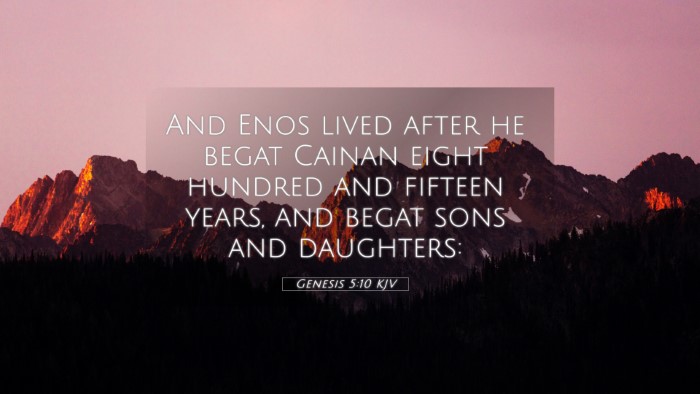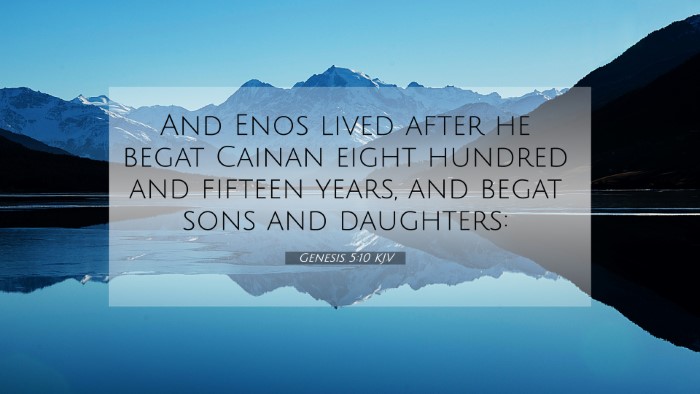Meaning of Genesis 5:10
Genesis 5:10: "And Methuselah lived after he begat Lamech seven hundred eighty and two years, and begat sons and daughters."
Summary of Insights
This verse highlights an important generational connection in the lineage of Adam through Methuselah, the father of Lamech. The longevity of Methuselah is significant as it reflects the early biblical understanding of lifespan and divine favor.
Key Themes
- Generational Legacy: Methuselah’s long life signifies the importance of familial ties and the continuation of lineage.
- Divine Time: The life spans in Genesis often represent divine grace and the covenantal promises God has towards humanity.
- Humanity’s Expansion: The mention of "sons and daughters" indicates the growth of humanity, fulfilling God’s command to multiply and fill the earth.
Commentary Insights
Matthew Henry's Commentary
Matthew Henry emphasizes that Methuselah’s age reflects God’s mercy towards a wicked world at that time and serves as a reminder of God’s patience before judgment. This demonstrates the connection between divine grace and human history.
Albert Barnes' Commentary
Albert Barnes notes the comparative aspects of Methuselah’s lifespan to his role in biblical history. He links this verse to the broader narrative of the antediluvian period, examining the implications of long lives leading to increased populations which become significant in the context of the Flood.
Adam Clarke's Commentary
Adam Clarke reflects on the mystical significance of the names mentioned, particularly “Methuselah,” which means “his death shall bring,” hinting at the rich layers of prophetic elements embedded within biblical genealogies.
Cross-References to Genesis 5:10
- Genesis 5:27: The life of Methuselah extends for a remarkable 969 years, inviting deeper reflection on divine timing.
- Genesis 6:3: God’s Spirit striving with humanity demonstrates the urgency and limitations of time leading up to the Flood.
- Genesis 4:26: The establishment of worship and calling upon the Lord highlights growing spiritual dynamics in the early generations.
- Luke 3:37: The genealogical record in the New Testament links back to Methuselah, indicating continuity and fulfillment of God's promises.
- Hebrews 11:5: The mention of Enoch alongside Methuselah illustrates the theme of faith and righteousness in a corrupt generation.
- Jude 1:14: Speaks of Enoch, who was the seventh from Adam, linking this lineage to prophetic pronouncements of judgment.
- Genesis 9:1: God’s blessing and command to Noah reflects the ongoing theme of population growth starting from the early generations.
Thematic Connections
Genesis 5:10 serves as a pivotal verse in understanding the lineage and the narrative arc of humanity in the early chapters of Genesis. The age of Methuselah ties into themes of:
- Divine Grace: The prolongation of lives can be seen as grace extended to humanity.
- Faithfulness: The continuation of the godly line through generations highlights faithfulness in God’s covenant.
- Judgment and Mercy: The juxtaposition of long lives against the impending judgment of the Flood reflects the duality of God’s nature—merciful yet just.
Practical Applications
Understanding Genesis 5:10 encourages deeper study into the nature of God's patience and the importance of living a life that recognizes the weight of generations. It invites us to:
- Consider our own legacy and its impact on future generations.
- Recognize God’s long-suffering nature in our lives.
- Embrace the significance of family and community in spiritual lineage.
Conclusion
Genesis 5:10, through its intricate details and genealogical importance, opens a door to understanding the complex interrelations within the Biblical narrative. By exploring the connections between this verse and others, we can gain profound insights into the themes of divine grace, judgment, and the continuity of God's purposes from generation to generation.


